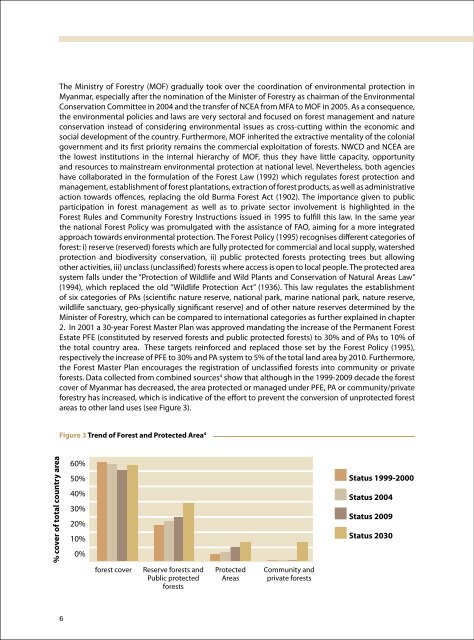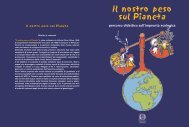Myanmar Protected Areas: Context, Current Status ... - Istituto Oikos
Myanmar Protected Areas: Context, Current Status ... - Istituto Oikos
Myanmar Protected Areas: Context, Current Status ... - Istituto Oikos
You also want an ePaper? Increase the reach of your titles
YUMPU automatically turns print PDFs into web optimized ePapers that Google loves.
% cover of total country area<br />
The Ministry of Forestry (MOF) gradually took over the coordination of environmental protection in<br />
<strong>Myanmar</strong>, especially after the nomination of the Minister of Forestry as chairman of the Environmental<br />
Conservation Committee in 2004 and the transfer of NCEA from MFA to MOF in 2005. As a consequence,<br />
the environmental policies and laws are very sectoral and focused on forest management and nature<br />
conservation instead of considering environmental issues as cross-cutting within the economic and<br />
social development of the country. Furthermore, MOF inherited the extractive mentality of the colonial<br />
government and its first priority remains the commercial exploitation of forests. NWCD and NCEA are<br />
the lowest institutions in the internal hierarchy of MOF, thus they have little capacity, opportunity<br />
and resources to mainstream environmental protection at national level. Nevertheless, both agencies<br />
have collaborated in the formulation of the Forest Law (1992) which regulates forest protection and<br />
management, establishment of forest plantations, extraction of forest products, as well as administrative<br />
action towards offences, replacing the old Burma Forest Act (1902). The importance given to public<br />
participation in forest management as well as to private sector involvement is highlighted in the<br />
Forest Rules and Community Forestry Instructions issued in 1995 to fulfill this law. In the same year<br />
the national Forest Policy was promulgated with the assistance of FAO, aiming for a more integrated<br />
approach towards environmental protection. The Forest Policy (1995) recognises different categories of<br />
forest: i) reserve (reserved) forests which are fully protected for commercial and local supply, watershed<br />
protection and biodiversity conservation, ii) public protected forests protecting trees but allowing<br />
other activities, iii) unclass (unclassified) forests where access is open to local people. The protected area<br />
system falls under the “Protection of Wildlife and Wild Plants and Conservation of Natural <strong>Areas</strong> Law”<br />
(1994), which replaced the old “Wildlife Protection Act” (1936). This law regulates the establishment<br />
of six categories of PAs (scientific nature reserve, national park, marine national park, nature reserve,<br />
wildlife sanctuary, geo-physically significant reserve) and of other nature reserves determined by the<br />
Minister of Forestry, which can be compared to international categories as further explained in chapter<br />
2. In 2001 a 30-year Forest Master Plan was approved mandating the increase of the Permanent Forest<br />
Estate PFE (constituted by reserved forests and public protected forests) to 30% and of PAs to 10% of<br />
the total country area. These targets reinforced and replaced those set by the Forest Policy (1995),<br />
respectively the increase of PFE to 30% and PA system to 5% of the total land area by 2010. Furthermore,<br />
the Forest Master Plan encourages the registration of unclassified forests into community or private<br />
forests. Data collected from combined sources 4 show that although in the 1999-2009 decade the forest<br />
cover of <strong>Myanmar</strong> has decreased, the area protected or managed under PFE, PA or community/private<br />
forestry has increased, which is indicative of the effort to prevent the conversion of unprotected forest<br />
areas to other land uses (see Figure 3).<br />
Figure 3 Trend of Forest and <strong>Protected</strong> Area 4<br />
60%<br />
50%<br />
40%<br />
30%<br />
20%<br />
10%<br />
0%<br />
forest cover Reserve forests and <strong>Protected</strong><br />
Public protected<br />
forests<br />
<strong>Areas</strong><br />
Community and<br />
private forests<br />
<strong>Status</strong> 1999-2000<br />
<strong>Status</strong> 2004<br />
<strong>Status</strong> 2009<br />
<strong>Status</strong> 2030<br />
Background on <strong>Myanmar</strong><br />
Since the 1990s <strong>Myanmar</strong> has also increased the participation in the international fora regarding<br />
environmental matters which resulted in the signing of several international environmental agreements<br />
which are given in Appendix 2.<br />
Policy implementation<br />
As for any other government policy, the effectiveness of environmental policies depends mostly on<br />
the political will and the availability of resources to implement it. Biodiversity conservation is hardly<br />
being given the first priority, especially in developing countries where it is generally perceived as a<br />
constraint to economic development. Furthermore, the legal and institutional constraints described<br />
above have an impact on the execution and enforcement of such policies. On one hand, the sectorspecific<br />
policies leave gray areas (e.g. no procedures or rules for Environmental Impact Assessments)<br />
or produce overlapping (e.g. marine national parks fall under both Ministry of Forestry as protected<br />
areas and Ministry of Livestock and Fisheries for the conservation of marine resources). The lack of<br />
coordination is not only between different ministries or departments but also between centre and<br />
peripheries. Although <strong>Myanmar</strong> state is highly centralised and most decisions are taken from centre,<br />
localities have ways of blocking and influencing decisions, for instance through slow and inaccurate<br />
information flow. Alongside the legal and institutional framework, it is important to consider the<br />
attitudes of the individuals towards conservation. The conservation and management of PAs rest with<br />
forest officers who are specifically trained in planning and implementing forestry operations. Most forest<br />
officers are not acknowledgeable of the ecological functions of ecosystems and recognize only a few<br />
tree species as valuable. Thus their professional judgment, summed up with the lack of incentives (low<br />
salaries and no travel allowance) and the low perceived control from the centre, reinforces the general<br />
attitude of neglecting PAs. However, many of NWCD staff are very dedicated to conservation, especially<br />
those who have received training abroad or from international agencies, and play a remarkable role<br />
4 Data for the period 1999-2000 are from FAO, Asia and the Pacific National Forestry Programmes: Update 34, December 2000. Data for 2004 are from Forest<br />
Research Institute, <strong>Status</strong> of forest genetic resources, their conservation and management in <strong>Myanmar</strong>, Presentation by Aung Zoe Moe 2004. Data for 2009 are<br />
from NCEA, Sustainable Forest Management: Perspectives on REDD development, Presentation by Htwe Nyo Nyo 2009.<br />
5 One example is the famous Buddhist monk Maing Fone of Par Sar, thanks to whom the protected area has been established and conserved so far without the<br />
allocation of staff and resources by FD.<br />
6 In 2010 the Forest Department reported international cooperation with the following organisations: Asian Wetland Census (AWC), Birdlife International<br />
(BLI), California Academy of Science (CAS), Global Tiger Forum (GTF), International Crane Foundation (ICF), <strong>Istituto</strong> <strong>Oikos</strong>, Makino Botanical Garden (MBK),<br />
Smithsonian Institute (SI), Wild Bird Society of Japan (WBSJ), Wildlife Conservation Society (WCS), World Conservation Union (IUCN), World Pheasant Association<br />
(WPA). Other organizations are working in <strong>Myanmar</strong> without official recognition.<br />
6 7<br />
L. Beffasti






